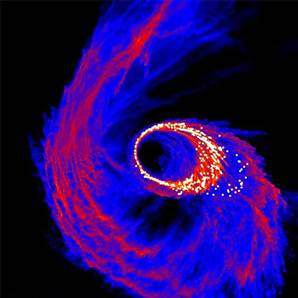
No, it's not the next soft-drink campaign. "Dark gulping" is a new hypothesis about how giant black holes might have formed from collapsing dark matter.
Supermassive black holes are a mystery. These behemoths can pack the mass of billions of suns, and often lurk in the centers of big galaxies like the Milky Way. But scientists don't know how they got started nor how they grew so massive.
A new computer model suggests dark gulping is one possible route to forming these monsters. The idea involves invisible dark matter, which is stuff of unknown nature that astronomers know exists because they see its gravitational effects on galaxies......In this scenario, a large cloud of dark matter could interact with gas to form a dense central mass. Depending on how the dark matter stores heat, this mass could be unstable. A small disturbance might prompt the dark matter to collapse quickly, gulping itself down to create a black hole. Though it would originally be invisible, soon it would gobble down regular matter and gas and, with all that material swirling in and being superheated and luminous, become visible.
This hypothesis seems plausible, but there is no proof yet that it ever happened, said Kinwah Wu, an astrophysicist at University College London's Mullard Space Science Laboratory, who built the model with colleague Curtis Saxton.
"It's a viable, possible scenario," Wu told Space.com. "The model works, but it doesn't mean that nature behaves like that. We need more observational proof or disproof of this."
Saxton will present the findings this week at the European Week of Astronomy and Space Science at the University of Hertfordshire in Hatfield, England.
Black holes can't be seen because once light and matter get inside one, they are trapped. But on the way in, all the material creates a chaotic mess of radiation that does escape into space. From observations of faraway quasars — bright objects thought to be anchored by black holes and surrounded by intense star formation — scientists think that supermassive black holes existed when the universe was less than a billion years old. Yet most theories about these gigantors can't explain how they formed so early.
Supermassive black holes are a mystery. These behemoths can pack the mass of billions of suns, and often lurk in the centers of big galaxies like the Milky Way. But scientists don't know how they got started nor how they grew so massive.
A new computer model suggests dark gulping is one possible route to forming these monsters. The idea involves invisible dark matter, which is stuff of unknown nature that astronomers know exists because they see its gravitational effects on galaxies......In this scenario, a large cloud of dark matter could interact with gas to form a dense central mass. Depending on how the dark matter stores heat, this mass could be unstable. A small disturbance might prompt the dark matter to collapse quickly, gulping itself down to create a black hole. Though it would originally be invisible, soon it would gobble down regular matter and gas and, with all that material swirling in and being superheated and luminous, become visible.
This hypothesis seems plausible, but there is no proof yet that it ever happened, said Kinwah Wu, an astrophysicist at University College London's Mullard Space Science Laboratory, who built the model with colleague Curtis Saxton.
"It's a viable, possible scenario," Wu told Space.com. "The model works, but it doesn't mean that nature behaves like that. We need more observational proof or disproof of this."
Saxton will present the findings this week at the European Week of Astronomy and Space Science at the University of Hertfordshire in Hatfield, England.
Black holes can't be seen because once light and matter get inside one, they are trapped. But on the way in, all the material creates a chaotic mess of radiation that does escape into space. From observations of faraway quasars — bright objects thought to be anchored by black holes and surrounded by intense star formation — scientists think that supermassive black holes existed when the universe was less than a billion years old. Yet most theories about these gigantors can't explain how they formed so early.

No comments:
Post a Comment